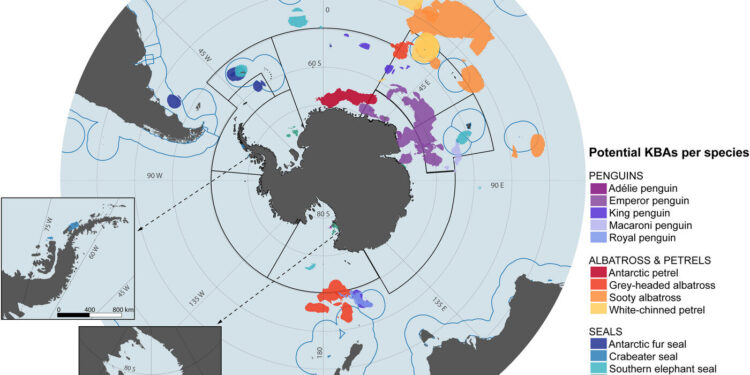Potential Key Biodiversity Area (KBA) sites representing high-use areas for seabird and pinniped species. Credit: Conservation biology (2024). DOI: 10.1111/cobi.14345
A team of scientists led by the University of Colorado Boulder has identified 30 new areas critical to biodiversity conservation in the Southern Ocean surrounding Antarctica. In a study published Aug. 15 in the journal Conservation biologyResearchers warn that without better protection to limit human activities in these areas, native wildlife could face significant population declines.
“There are many animals that live only in the Southern Ocean, and they all play important roles in its ecosystem,” said Cassandra Brooks, lead author of the study and an associate professor in the Department of Environmental Studies and a member of the Arctic and Alpine Research Institute at the University of Colorado Boulder. “Although Antarctica and the Southern Ocean seem far away, they — and the life they support — are essential to the functioning of Earth’s systems,” she added.
The Southern Ocean is home to many beloved animals, including Adélie penguins, Weddell seals and humpback whales. Its remoteness and harsh conditions, including freezing temperatures and extensive sea ice, have largely protected the biodiversity of Antarctica and the Southern Ocean from human activities.
“Although the planet is in the midst of a mass extinction, the Southern Ocean in Antarctica is one of the few places in the world where no known species have gone extinct,” said Sarah Becker, first author of the study and a doctoral student in the Department of Environmental Studies.
But with global warming and melting ice, fishing and tourism have increased in the region. These human activities not only compete with wildlife for resources, but can also cause stress and introduce invasive species and diseases against which native wildlife have few or no defense mechanisms.
Becker, Brooks and their team set out to identify key biodiversity areas (KBAs) in the Southern Ocean that species depend on for the survival of their populations.
They used existing tracking data for 13 Antarctic and sub-Antarctic seabirds and seals (e.g. Adélie penguins, sooty albatrosses and southern elephant seals) and identified 30 KBAs in the Southern Ocean. These sites represent marine habitats to which species move for feeding, breeding and migration.
Previous work to identify large-scale conservation areas in the Southern Ocean has tended to lump different species together into a single dataset to find areas that are important to multiple species. While this approach is a critical part of conservation planning, it can overlook areas that are critical to some species because of their unique life stages and migration patterns, Becker said.
For example, the team discovered two large sites in the waters near Amanda Bay in East Antarctica that are critical feeding grounds for many emperor penguins as they recover from breeding. The researchers also identified several sites in the waters near Campbell Island, south of New Zealand, where a breeding population of the endangered grey-headed albatross feeds. Other similar large-scale conservation efforts, such as Important Bird Areas or Ecologically and Biologically Significant Areas, have not prioritized these sites.
“Our study bridges the gap between the large-scale perspective and the specific needs of individual populations, adding an important layer of detail,” Becker said.
The researchers hope that international agencies and governments will take these findings into account when developing conservation strategies and determining areas where fishing should be restricted.
“By reducing interactions with fishing or tourism in these key biodiversity areas, we can potentially give these animals the best chance to adapt and become resilient to climate change,” said Brooks, who is also a member of CU Boulder’s Arctic and Alpine Research Institute.
The Southern Ocean is one of the major buffers of climate change. Its cold waters capture 40% of the world’s human-caused carbon dioxide emissions and 60 to 90% of the excess heat from climate change.
“Antarctica is far away, but what’s happening there doesn’t stop there,” Brooks said. “The wildfires here in Colorado are connected to what’s happening in the Southern Ocean. By doing more to protect Antarctica, we can actually create a more livable world for all of us.”
More information:
Sarah L. Becker et al., Strengthening ocean conservation through the recognition of key biodiversity hotspots in the Southern Ocean from multi-species tracking data, Conservation biology (2024). DOI: 10.1111/cobi.14345
Provided by University of Colorado Boulder
Quote:As Human Activities Expand in Antarctica, Scientists Identify Crucial Conservation Sites (2024, August 15) Retrieved August 15, 2024, from
This document is subject to copyright. Apart from any fair dealing for the purpose of private study or research, no part may be reproduced without written permission. The content is provided for informational purposes only.



